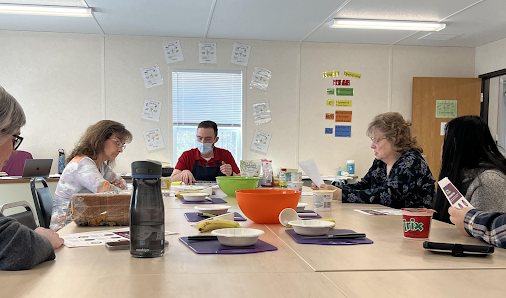
FARMINGTON – Franklin County Adult and Community Education has partnered with the Healthy Community Coalition to offer its students nutrition education opportunities in a classroom setting.
The adult education director, Nancy Allen, said that course idea came from strategic planning; educators were looking for a way to bridge the gap between life skills learned in the classroom and those learned at home, and students expressed an interest in meal planning and budgeting.
College Transitions Coordinator Sandra Brown explained the value of having collaborated to offer such a program in the adult education setting.
“We usually have a couple students that don’t talk to each other in class, so this has created an amazing community feeling for them … food always gathers people together,” Brown said. “Food insecurity is so rampant in 16 to 20 year olds but nobody wants to talk about it and you don’t always know what people need until they tell you. Lucky for us, our students are willing to disclose what they need.”
With nine students currently enrolled, classes average an hour in length, but if the conversation is going well, Brown encourages it to continue. She hopes to be able to fit in one more six-week course before the end of the school year, but she also hopes to be able to expand the program and open classes to the entire community.
Students are also learning much more than meal planning and budgeting: they’re learning to look at nutritional content labels for facts and ingredients, discussing the nutritional values and benefits of ingredients and reviewing and preparing recipes in the classroom. David Scammon, a coordinator with the Supplemental Nutrition Assistance Program’s education initiative, brings enough ingredients and equipment to encourage full cooperation, and participation has never been a problem.
“We primarily focus on increasing fruit and vegetable consumption. We talk about the different food groups and the different sized portions—for this class in particular we talk about getting that variety and doing it on a budget,” Scammon said.
Scammon uses program funding to purchase products and make ingredient and cost comparisons between products. He also stated that the classroom data he’s received as a result of the program has a qualitative benefit.
“They feel more confident—I think that’s the biggest thing—that they can make healthier choices. They’re more enthusiastic about it, too, from what I’ve seen; you not only are saving money and cooking food that tastes good, but it’s also fun.”




